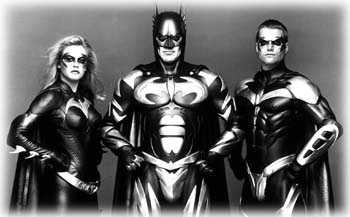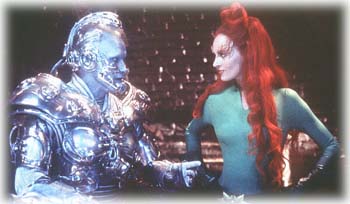![[Metroactive Movies]](/movies/gifs/movies468.gif)
![[Metroactive Movies]](/movies/gifs/movies468.gif)
[ Movies Index | Metro | Metroactive Central | Archives ]
Cotton Candy Man
The costumes are the characters in director Joel Schumacher's 'Batman and Robin'
More like Cats than bats, and a franchise-killer if ever there was one, Batman & Robin is thick with day-glo paint and stuffed with exotic costumes. The last remaining bits of Tim Burton's visionary first two films have been flushed out to make way for a spectacle too gauche even for the Ice Capades.
Long before he directed Batman & Robin, and the previous installment in the series, Batman Forever, Joel Schumacher was a costume designer, creating the wardrobe for Woody Allen's Sleeper. His old profession has come back to him. These characters are their costumes--and nothing more. They fuss over the details of them; they compliment each other on them. It's like watching models preen at a costume party.
"There's something about anatomically correct rubber suits," Poison Ivy (Uma Thurman) says, flirting with our hero. The opening scenes slam the sartorial point home: the sound of the snapping on of gauntlets and the full-screen close-ups of the shiny codpiece and the Bat-butt.
Mr. Freeze (Arnold Schwarzenegger) is out stealing diamonds to power his climate-controlled suit; like Poison Ivy, he was transformed into a monster when he was dunked in toxic chemicals (the "birth of the Joker" motif from the first Batman is here used twice for good measure).
Poison Ivy is a renegade Earth Firster trying to cross-breed plants and snakes so that the rainforest can defend itself against clear-cutting. After her own baptism in chemicals, Ivy comes to Gotham City to take revenge on her former boss Bruce Wayne.
Ivy and Freeze join forces. Freeze's interest in killing off the city is to get revenge for his wife's death, supposedly at the hands of Batman (George Clooney). Here, the apocalypse carries no threat--a complicated piece of technology is introduced early on so that we know it will be used to rescue Gotham City later.
Alfred the Butler's niece has turned up from "Oxbridge" to stay at Wayne Manor for a spell--thanks to the inescapable advertising campaign, we know she's going to become Batgirl (Alicia Silverstone). It's probably significant that Batgirl, a character created for the TV show during its final season in 1967, was a response to falling ratings--a cry for help.
Though Batgirl also acts as sort of a female chaperone for Robin, the Boy Wonder, for those few who still speculate about the exact nature of Bruce Wayne and Dick Grayson's relationship. Chris O'Donnell, still one of current cinema's least-entertaining actors, tries (as always) to mix street wisdom with prep-school archness.
In the era in which Pat Boone is back on the charts, O'Donnell is right at home on screen; he's like one of those boys that mothers want their daughters to date.
Story-Free Filmmaking
Trying to wedge as many characters as possible into the film has destroyed the mood completely. And yet, considering how much motivation has to be supplied for all of the characters, Batman & Robin is surprisingly story-free.
There's a dull motorcycle race out of nowhere in the middle, presumably to kill time. Part of the race is conducted in that particularly overfilmed stretch of the concrete-bound Los Angeles River that should never, ever be used in a movie again.
This aimlessness, despite the crowds on screen, probably accounts for the film's effort to add "heart" by having Alfred (Michael Gough) sicken. Alfred telegraphs his intention to become seriously ill with a line about how he won't be around forever (a low bass groan on the soundtrack underscores the announcement--Schumacher should have had Gough cough a few times, in case any really slow kids missed the cue).
The illness persists slowly throughout the movie. Gough, distinguished 80-year-old thespian that he is, uses all of his time-honed skills to restrain his lunch as Clooney tells him, "I love you, old man." This sequence is precisely the sort of thing people go to Batman movies to get away from.
By the TV's Light
Schumacher recycles the Freeze origin story from The Adventures of Batman and Robin, which is in reruns on the Fox Network and still superior in every way. In those cartoon episodes, as here, Freeze was a scientist who froze his terminally ill wife trying to cure her, and who spends time gazing at a snow-globe in which an image of her is preserved.
(The third and best Mr. Freeze episode from The Adventures of Batman and Robin had a witty reference to the persistent urban legend that Walt Disney has himself been frozen in hopes of revival. The "Disney" figure nursed his own world-domination scheme--a thinly disguised Disneyworld was his breeding ground for perfect human specimens.)
Akivah Goldsman's screenplay isn't nearly up to the writing on The Batman Adventures; and he makes every joke broad and flat. The self-referential gags are more like toy commercials than inside jokes. Ivy, for example, jests, "I'm a lover not a fighter. That's why every Poison Ivy action figure comes with hips!"
You could defend the stupidity of Batman & Robin in the name of camp, but if you actually watch the old Batman shows, you'll see that the actors didn't feel it necessary to try to top the comic-book settings. There wasn't half the gesticulation you see in Batman & Robin in a whole season of the 1966-68 TV show. There, George Sanders' Mr. Freeze continued the cool style of that actor's vinegary persona; Cesar Romero's Joker was as dandified, frightening and charismatic on the small screen as he had been on the big one.
The official Batman & Robin site.
A page about the animated TV series.
A page about Batman TV series from 1960s.
Mantle of the Bat: an online zine devoted to the dark knight.
The early days of the comic book.
Camping in Gotham City
There's so much camping in Batman & Robin that the actors only get a chance to show their talents for a second or so. Schwarzenegger is miscast as a polysyllabic mad scientist, and Thurman always looks ridiculous as a vamp.
She turns up at one crowd scene disguised in a polyester gorilla suit--a lift from Marlene Dietrich's "Hot Voodoo" number in Josef von Sternberg's Blonde Venus (1932). But it doesn't work because, plainly, Schumacher is no von Sternberg--he has no deep interest in lighting Thurman's face to make her ravishing.
The one instance of Thurman as icon--when she's caught in firelight for a moment--is bypassed swiftly. Similarly, in the scene in which Freeze is tortured by two guards at Arkham Asylum, a mood of pity starts to well up, but Schumacher stamps that out as well.
(I did, however, feel for Schwarzenegger every time I saw his badly bloodshot eyes--those steely contact lenses must have been murder on his corneas. Maybe I sympathized because I was coming down with conujunctivitis from all of the ultraviolet lighting Schumacher was using.)
As the Bat, Clooney is remote without being mysterious. He looks somewhat lost, half in a snit, perhaps ashamed of himself for being there. He has toned down his accent (it only slips occasionally: "We hafta blow up this rawket"). Most of the shots of him are in medium close-up as he stands stock still and delivers Goldsman's dialogue. Clooney doesn't move well--under Schumacher's direction, there's nothing for him to move toward.
There was one shot of Clooney in half-shadows, wearing a very, very expensive tuxedo, that made some of the women in the audience sigh, but naturally, Schumacher cut away to one of the immense, tacky, ugly disco/bathhouse sets he loves so much.
These sets are such a tribute to '70s film tack (remember Xanadu and Can't Stop the Music?) that they ought to pump the reek of poppers through the theater vents and have a cameo appearance by Bette Midler in a bath towel. (Even our old friend the spinning disco ball turns up in a long shot during the motorcycle race.)
Tim Burton, in his interviews for Burton on Burton (Faber and Faber), defended his dark-night approach to the figure of the solitary and strange Batman: "If you want to make it bright and light, you do Superman or Cotton Candy Man." In this odious, garish film, Cotton Candy Man debuts--and, with any luck, dies.
[ Metro | Metroactive Central | Archives ]





Batman & Robin (PG-13; 125 min.), directed by Joel Schumacher, written by Akiva Goldsman, photographed by Stephen Goldblatt and starring George Clooney, Arnold Schwarzenegger and Uma Thurman.
Web exclusive to the June 19-25, 1997 issue of Metro.